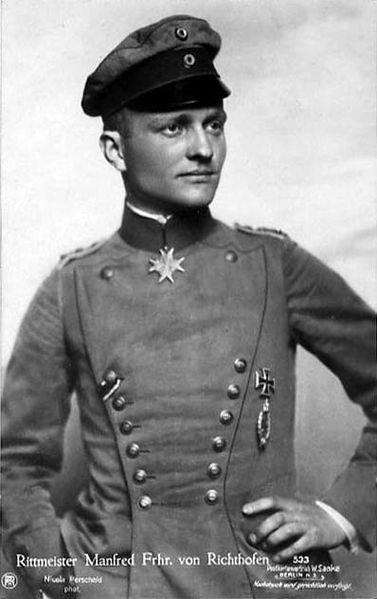*Image Credit: Wikimedia Commons World War I represented a monumental shift in the way opposing forces entered combat. Among the innovations in destruction employed in the conflict, tanks and poisonous gas are often cited, but no invention would change how nations fought quite like the addition of the airplane. Powered flight had been a reality for hardly more than a decade, yet its rapid advance naturally led countries to employ pilots in securing the skies — none more famous than Manfred von Richthofen, the German flyer who would be referred to as the Red Baron. Growing up as part of the Prussian nobility, von Richthofen lived in modern Poland as a boy. At the tender age of 11 — roughly the time the Wright Brothers were taking flight at Kitty Hawk — he entered a military school, eventually completing his education in 1911. Joining a cavalry unit, he spent most of his early career working snooping on the activities on the armies of nations on Germany’s always-contentious borders with Russia, France and Belgium. In May 1915, while away from the front, von Richthofen noticed a military aircraft parked on the tarmac and immediately applied for a transfer to the Imperial German Army Air Service. Seeking to be engaged in battle more often, he hoped taking the controls of a plane would help him to do so. Within weeks, he was training as an observer, sitting behind the pilot and defending the aircraft with the machine gun mounted to his seat. By October, after meeting with German ace Oswald Boelcke, von Richthofen had managed to find his way into the pilot seat. When he made his first flight the following March, he crashed. Considered by most to be inadequate, von Richthofen proved to be a quick study and soon mastered the aerial ballet well enough to manage an unconfirmed kill over Verdun in April 1916. Having gained a reputation as competent pilot by the end of summer, Boelcke tapped von Richthofen to join him in a new fighter squadron heading toward the Eastern Front. Dogfighting over Cambrai, France on September 17, 1916, he managed his first confirmed kill. Beaming with pride when he landed, the young German flyer headed to a jewelry shop in Berlin to order a silver cup with details of the victory engraved on it. By the time rationing prevented the sale of silver, he had 60 such trophies. Unwilling to have anything less than the best quality materials, he stopped buying cups to mark his triumphs. Over nearly two nears in service over the battlefields of World War I, von Richthofen would notch 80 confirmed kills, flying his trademark red airplane into battle and achieving hero status after the publication of his autobiography in 1917. Never a flashy pilot, he used solid tactical understanding and a simple downward attack (using the sun to blind his opponent) to put his excellent shooting skills to work. Late in the morning of April 21, 1918, flying low over Morlancourt Ridge in northern France in pursuit of a British aircraft, von Richtofen was shot in the chest. Bleeding internally from lacerations to his heart and lungs, he managed to land safely just north of Vaux-sur-Somme dying just after members of the Australian Imperial Force reached his plane.
September 17, 1916 CE – Manfred von Richthofen Downs His First Enemy Fighter and the Legend of the Red Baron is Born
*Image Credit: Wikimedia Commons World War I represented a monumental shift in the way opposing forces entered combat. Among the innovations in destruction employed in the conflict, tanks and poisonous…
380
